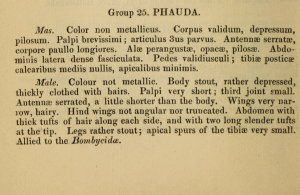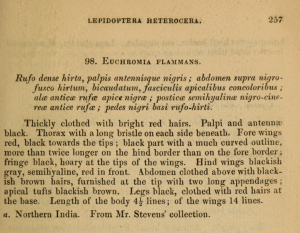

 +4Kontinente:AS
+4Kontinente:AS3. Biologie
3.1. Nahrung der Raupe
- [Moraceae:] Ficus microcarpa
- [Moraceae:] Ficus racemosa
Die Raupe gilt in Hongkong, Nord-Indien und im Süden Chinas als massiver Schädling an Feigen-Bäumen, im wesentlichen dadurch, dass die Raupen die beliebten Stadtbäume mitunter komplett kahl fressen. Zheng et al. (2015) etwa beginnen ihren Aufsatz: "Ficus spp. trees are the main avenue species in the urban landscape of Southeast Asian countries and southern provinces of China. These trees play an important role in maintaining the ecological balance by actively participating in the cycling of nutrients and gases (e.g., carbon dioxide and oxygen) and providing an enormous leaf area for impingement, absorption and accumulation of air pollutants (e.g., industry, construction materials and vehicle emissions) to reduce the pollution level in the urban atmosphere [3]. Clearly, these functions are weakened when leaves of Ficus spp. trees are eaten by herbivorous insects. Phauda flammans Walker (Lepidoptera: Zygaenidae) is one of the notorious defoliators on Ficus microcarpa L. (Urticales: Moraceae) and F. racemosa L. (Urticales: Moraceae) in P.R. China [8–10], and on F. racemosa in India [12, 13]. Phauda flammans has two generations per year in Nanning City, Guangxi Zhuang Autonomous Region, P.R. China. Larval peak of the first and second generations occurred from mid-May to late June and early August to mid-October, respectively. Larvae of the second and third generations overlapped, which could attribute to the longer developmental duration of larvae. This pest overwintered as the pre-pupae larvae and pupae of the second generation and young larvae of the third generation. Only a few individuals could overwinter in up to 10 mm soil depths."
4. Weitere Informationen
4.1. Andere Kombinationen
- Euchromia flammans Walker, 1854 [Originalkombination]
4.2. Faunistik
Die Art wurde aus dem Norden Indiens beschrieben, wo sie wie im Süden Chinas, in Hongkong und Myanmar als Schädling an Feigenbäumen im Stadtbild gilt.
(Autor: Erwin Rennwald)
4.3. Literatur
- Erstbeschreibung: Walker, F. (1854): List of the Specimens of Lepidopterous Insects in the Collection of the British Museum 1: 1-278.[Digitalisat auf archive.org]
- Zheng, X.-L., Li, J., Liu, J.-Y., Meng, L.-Y., Lin, M.-Y., Zhang, J. & W. Lu (2015): Ecological and morphological characteristics of parasitoids in Phauda flammans (Lepidoptera, Zygaenidae). — Parasite, 22 (36): 1-6. DOI: 10.1051/parasite/2015036. [zum PDF-Download auf researchgate.net]








